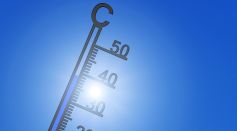ENVIRONMENT & CLIMATE
Minor Volcanic Eruptions Underwater Can Create Havoc, Resulting to Ash Clouds, Landslides, and Major World Issues
Amputation Surgery Awaits British Teenager Due to Poisonous Brown Spider; Here Are Life Saving Tips After a Spider Bite

Extreme Weather Events Linked to Global Warming and Anomalies in Polar Vortex
Sweet White Flower's Secret Carnivore Stems Uncovered; Scientists Found It’s a Carnivorous Insect Killing Plant

Sea Level Rise Projection Tool: NASA, IPCC Develops Free Online Portal to Help Plan Ahead of the Effects of Rising Seas

'Tightening The Net': New Report Warns About 'Net Zero' Carbon Targets Distracting the Public

Google Wants To Recycle Hard Drives With the Help of Rare Earth Magnets
Australia's Ancient Dragon Fossil Unearthed, Fearsome Reptile Dominated Outback Skies

Should You Feed Your Dogs the Remains of Your Dinner? Scientists Warn Peas Could Increase Deadly Canine Heart Disease

Zoo Animals Fight With Each Other in Beijing After Witnessing a Tourist Brawl
Bristle Worms Unique But Weird Anatomical Structure Suggests Adaptation of Fungal Lifestyle

US Drought: Sinking of California's Farming Capital Corcoran Impact Town's Agribusinesses and Farming Industry
Mount Merapi Eruption 2021: Warning Signs of When a Volcano is About to Burst an Avalanche of Lava

Wildfires Devastate Evia Island Causing Greek Islanders to Flee Their Homes; How Do Heatwaves Impact Humans, Nature?
Most Popular

Memory and Learning: How the Brain Stores, Retrieves, and Forgets Information

Gut Microbiome 101: How Gut Bacteria Influence Immunity, Mood, and Metabolism

How Solar Activity Shapes Our Planet: What the Next Solar Maximum Means for Earth

Antibiotic Resistance: How It Develops and Why Misuse of Antibiotics Is Dangerous





